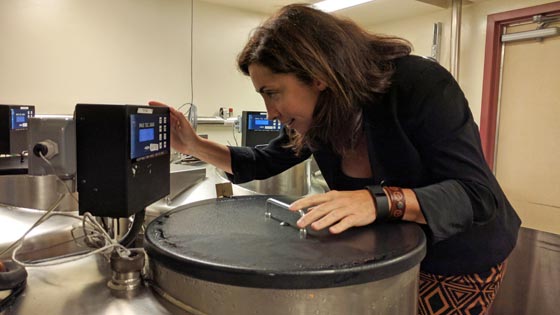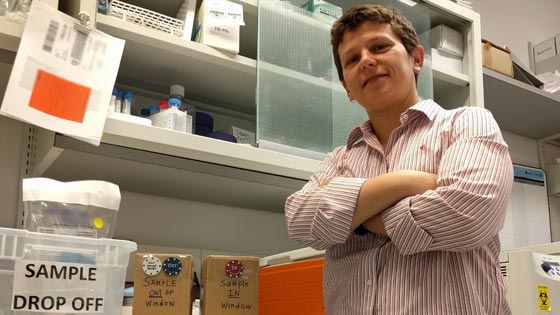
Roxanne MaCaskill, Quality Manger, Princess Margaret Cancer Centre, inspects the temperature readout on a quarantine tank. (Photo: UHN)
All Toyota employees use a standardized problem solving method, and it's a big part of what keeps the company at the top of the global auto manufacturing industry.
Now, UHN employees are learning to use the Toyota methodology too.
The Applied Problem Solving course teaches participants how to use the A3 method, an eight step process developed at Toyota for solving problems effectively by gathering data, and involving the people doing the work.
Equally important, they learn to tell a story about how they solved the problem. Telling a compelling story brings colleagues, subordinates and superiors along on the journey so they understand why the problem needed solving, what was causing it and the reasoning behind how the solution was selected.
That story is crucial for getting everyone onboard with the changes and ensuring the problem doesn't come back.
Finding the root cause
"When people say they are solving the same problem again and again, they've misunderstood," says Brenda Kenefick, Director, Lean Process Improvement. "It was never actually solved – they did not address the root cause, in fact they probably created a work around.
"People who've taken the course tell me they found lasting solutions to problems that have existed for years."
Three participants from the most recent class shared their stories about the problems they faced and how they solved them.
About the A3 Process
Using the A3 process developed at Toyota, so-named for the size of paper the story is printed on, participants move through eight steps:
- Describe the problem and tie it to a higher-level goal.
- Go see the process to determine where the problem is occurring and find out how often it happens.
- Set a goal – how much of the problem can be solved?
- Brainstorm potential causes for the problem then track how often they actually occur.
- Identify possible countermeasures, and choose the best ones.
- Implement the countermeasure.
- Monitor the results.
- If the countermeasures work properly, make them the new standard way of working.
What to do with an extra 15 minutes?
Some spinal cord rehab patients at Lyndhurst need a special mattress designed to prevent pressure ulcers. Clinicians were spending, on average, 22 minutes a couple times a week searching for them, and in some cases up to an hour.
The equipment is shared across three units and therapists used to have to check empty beds and storage rooms on all three units to find the mattresses they were looking for.
"My goal was to reduce that time so the occupational therapists can spend more time doing what we want to do – patient care," says Colleen Anderson, occupational therapist, Toronto Rehab.
To eliminate all the time spent searching, Colleen and her team put together an electronic tracking system for the mattresses. They also added a step in their admissions process to ensure the tracking system is kept up to date.
"The electronic system has pros and cons," says Colleen. "It's not visual enough, it would be great to have a big board we could easily check and update, but we decided that because of the physical distances between storage areas, the tracking system had to be electronic to make it accessible from anywhere in the hospital."
So far the new system seems to be working, the average time to find a mattress is down to just seven minutes – including the time it takes to check the form.
"I learned how important it is to involve the people closest to the problem you're trying to solve because they know the process the best," says Colleen.
It's the process, not the people
The laboratory technicians in the Correlative Studies Program at Princess Margaret Cancer Centre process tens of thousands of blood samples every year. Many of the test results are used by researchers studying new cancer treatments, and must be processed within a very specific amount of time after the blood is drawn.
"Meeting the timelines can be challenging, given the sheer number of samples we have to process in a day," says Vanessa Speers, manager, Correlative Studies Program. "And it's only getting more difficult, our volumes are increasing at a rate of 35 per cent per year."
Vanessa and her A3 team's first step was collecting data to see how often tests were on time, how often they weren't, and how many misses could be avoided by the lab team changing how they worked.
"We used poker chips to track our performance," says Vanessa. "We set up an 'on time' box and a 'not on time box'. When a test was on time we put a chip in the first box. When it was late because of our team's processes we put a blue chip in the second box, when it was late for another reason we put in a white chip."
The data showed that roughly one out of 10 samples was late because of an internal process. The team set a goal to get that down to zero.
The data also showed most of the delays the team could control were related to three factors:
- Staffing shortages during meetings, lunch breaks and when vacations overlapped.
- Certain pieces of equipment, such as the centrifuge, created bottlenecks.
- Samples weren't organized by time of arrival so the team couldn't tell which ones to do first.
Having data identifying the problems made it much easier for the team to discuss what they could try to do differently, without pointing fingers.
"It was always difficult to address this issue in the past because I never wanted the staff to think that I thought they weren't doing their absolute best to process the samples on time", says Vanessa. "The data we collected showed it wasn't a question of work ethic or how people were functioning, it was the way we had designed our system."

Dropping poker chips into card board boxes helped Vanessa Speers, manager, Correlative Studies Program, determine where to focus to improve sample processing times. (Photo: UHN)
"We ended up making several changes that I don't think we would have considered before going through the problem solving process."
The solutions the team came up with were:
- Assigning one person to continue processing urgent samples during team meetings.
- Putting multiple samples through the centrifuge at the same time if they have the same requirements.
- Setting up, and organizing the sample inbox with the oldest deliveries at the front to make it clear which one to test next.
"We met our goal and we're now processing 85 per cent of samples on time, up from 68 per cent," says Vanessa. "I learned that small things can have a substantial impact on performance and I have some ideas for solving bigger problems using this technique in the future."
Problem solvers check assumptions at the door
Thanks to just two small changes, stem cell products from Autologous Transplant patients are now quarantined only half as often.
It's a win for patients because moving stem cells in and out of quarantine can cause potentially damaging temperature changes.
The Autologous Transplant Program treats patients with diseases such as Multiple Myeloma or Lymphoma. The treatment involves collecting stem cells from its patients and freezing them for re-infusion at a later date.
As part of the assessment to determine if a patient is ready and eligible for treatment, a blood sample is tested for diseases such as hepatitis. If the test results are positive, or if they aren't available when the patient comes in for the collection, the stem cells must be quarantined.
"We were quarantining 13 per cent of cases," says Roxanne MacAskill, Quality Manager, Princess Margaret Cancer Centre. "The data showed that on average seven per cent of quarantines were because the blood work results hadn't been reviewed when the patient came in for collection."
When Roxanne went and observed the clinic process in person she saw that patients were being sent to have bloodwork done after visiting the Autologous Transplant Clinic. Not surprisingly, some patients were forgetting to get their blood work done.
She also realized there was no process for clinic staff to check and see if the blood results were reviewed before the patient came back for collection.
Roxanne and her team introduced two countermeasures to close these process gaps.
"We started asking patients to have the bloodwork done before their clinic visit," says Roxanne. "This allowed the coordinators to check to ensure the blood work was done at the scheduled visit.
"We also created a visual reminder system to make sure the coordinators check on the results before the patient comes back to have the stem cells collected."
In the month after the countermeasures were implemented, cases requiring quarantine declined from 13 per cent to six per cent.
"The remaining six per cent of cases were attributed to issues outside of our control," says Roxanne. "We were able to decrease quarantines due to factors within our control by 100 per cent, and we've sustained those results for several months now."
